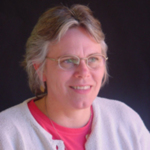Interviewer: Sara Khatib
Interview Date: November 10, 2020
Location: Interview conducted over Zoom
Duration: 1:10:33
Sherri Johnson arrived at Andrews Forest in 1996 to be a post-doc, having worked previously at the Luquillo LTER site (Puerto Rico). She joined the Pacific Northwest Research Station in 2001 as Scientist-in-Charge of the Andrews and has been a leader in the Andrews LTER program, specializing in aquatic ecology and forest-stream interactions.
Johnson begins the interview with discussion of definitions of ecology and ecosystems and notions of resilience and fragility. Coming from a disturbance ecology background, she tends to see systems as dynamic and having ecosystem-specific properties. She characterizes her own science approach as more experimental and applied than theoretical. Her focus is on water, which requires a landscape perspective encompassing influences from higher in the watershed. Considering the field of ecology as a whole, she discusses the recent development of stream ecology relative to other fields, such as limnology and terrestrial ecology. She mentions the International Biological Program and River Continuum project as places where Andrews made contributions to stream ecology broadly, and also some of the many areas of research focus in stream ecology – e.g., food webs, population ecology, species interactions, disturbance. She traces the development of thinking from a rather static view in the 1960s to a more dynamic view. She emphasizes her hands-on instincts for taking on manipulative, experimental work, despite the difficulty of doing it in streams, but, she points out, it is also important to be aware of the amount of site disturbance imposed by researchers. Research questions come to her from just wondering how things work, then observing them closely, and being critical of the emerging stories so as to be as objective as possible. She asserts that with age comes more acceptance of shades of gray when considering “truth,” which she describes in the context of field experiments on forest industry lands. In her world, uncertainty is more at play than “laws of nature.” She discusses some of her personal history leading to working in natural ecosystems, which is important to her.
The next set of questions concern approaches to science in the Andrews community. She discusses how all approaches are important, but rigorous hypothesis testing is particularly challenging in long-term research in a landscape like the Andrews with its long-lived forest and frequent disturbances. She explains that modeling has played an important role in Andrews science, including in the context of inter-site stream ecology experiments. She also discusses the dispersed character of the Andrews community, which has advantages and down sides.
The interview concludes with discussion of big contributions to science from the Andrews program, including a range of topics, such as roles of big wood in terrestrial and aquatic systems, biogeochemistry of a low-nitrogen system, the River Continuum Concept, and other topics. Johnson reflects on the nature of the research community and its unevenness over time and disciplines, and she also points out the absence of younger researchers in this set of oral histories.
Dublin Core
Title
Description
Johnson begins the interview with discussion of definitions of ecology and ecosystems and notions of resilience and fragility. Coming from a disturbance ecology background, she tends to see systems as dynamic and having ecosystem-specific properties. She characterizes her own science approach as more experimental and applied than theoretical. Her focus is on water, which requires a landscape perspective encompassing influences from higher in the watershed. Considering the field of ecology as a whole, she discusses the recent development of stream ecology relative to other fields, such as limnology and terrestrial ecology. She mentions the International Biological Program and River Continuum project as places where Andrews made contributions to stream ecology broadly, and also some of the many areas of research focus in stream ecology – e.g., food webs, population ecology, species interactions, disturbance. She traces the development of thinking from a rather static view in the 1960s to a more dynamic view. She emphasizes her hands-on instincts for taking on manipulative, experimental work, despite the difficulty of doing it in streams, but, she points out, it is also important to be aware of the amount of site disturbance imposed by researchers. Research questions come to her from just wondering how things work, then observing them closely, and being critical of the emerging stories so as to be as objective as possible. She asserts that with age comes more acceptance of shades of gray when considering “truth,” which she describes in the context of field experiments on forest industry lands. In her world, uncertainty is more at play than “laws of nature.” She discusses some of her personal history leading to working in natural ecosystems, which is important to her.
The next set of questions concern approaches to science in the Andrews community. She discusses how all approaches are important, but rigorous hypothesis testing is particularly challenging in long-term research in a landscape like the Andrews with its long-lived forest and frequent disturbances. She explains that modeling has played an important role in Andrews science, including in the context of inter-site stream ecology experiments. She also discusses the dispersed character of the Andrews community, which has advantages and down sides.
The interview concludes with discussion of big contributions to science from the Andrews program, including a range of topics, such as roles of big wood in terrestrial and aquatic systems, biogeochemistry of a low-nitrogen system, the River Continuum Concept, and other topics. Johnson reflects on the nature of the research community and its unevenness over time and disciplines, and she also points out the absence of younger researchers in this set of oral histories.

